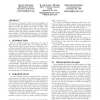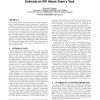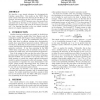29 search results - page 4 / 6 » ceas 2006 |
CEAS
2006
Springer
13 years 9 months ago
2006
Springer
The existance of networks of `bots' raises the possibility of a new type of spam that breaks the current paradigm of spam defense, in which the defence acts purely as a filte...
CEAS
2006
Springer
13 years 9 months ago
2006
Springer
Just as email spam has negatively impacted the user messaging experience, the rise of Web spam is threatening to severely degrade the quality of information on the World Wide Web....
CEAS
2006
Springer
13 years 9 months ago
2006
Springer
ISPs operate "abuse" teams to deal with reports of inappropriate email being sent by their customers. Currently, the majority of this work is dealing with insecure syste...
CEAS
2006
Springer
13 years 9 months ago
2006
Springer
In this paper, we describe how a large webmail service uses reputation to classify authenticated sending domains as either spammy or not spammy. Both SPF and DomainKey authenticat...
CEAS
2006
Springer
13 years 9 months ago
2006
Springer
We describe a very simple technique for discriminatively training a spam filter. Our results on the TREC Enron spam corpus would have been the best for the Ham at .1% measure, and...



